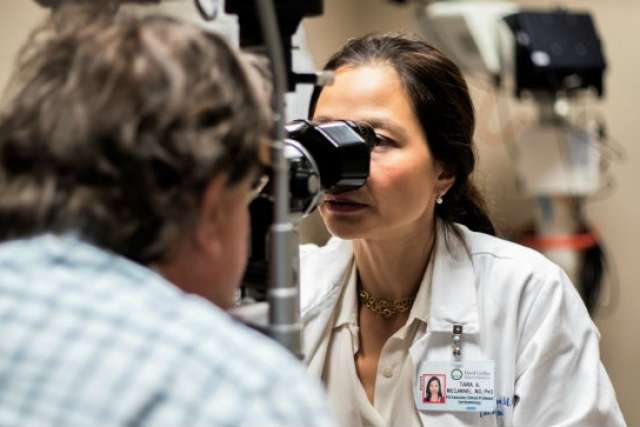Ocular melanoma is a rare form of eye cancer. Each year, only 2,500 people –or five in 1 million– are diagnosed. So why, as the news media reports, are a baffling number of newly diagnosed ocular melanoma cases cropping up in the southern United States?
To shed light on the issue, we consulted Dr. Tara McCannel, director of the ophthalmic oncology center at UCLA’s Stein Eye Institute and Doheny Eye Institute, and one of the nation’s leading experts in ocular melanoma.

Q. What is ocular melanoma?
A. McCannel: Ocular melanoma is a tumor that arises in the pigmented cells under the retina of the eye. We don’t know exactly what causes it. When detected early, the cancer is treatable and a person’s prognosis for vision and survival remains good. When the tumor is large or detected at an advanced stage, patients face a higher risk of metastasis and losing their eye. If the cancer spreads to the liver or lungs, the five-year survival rate drops to 15 percent.
Q. What could explain the rise of new cases in Alabama and North Carolina?
A. McCannel: Many of the newly diagnosed patients have lived at some point in the same geographic regions. Also, most of these patients are far younger than 55--the average age of diagnosis for ocular melanoma. These factors suggest that the patients may be remotely related and have inherited a genetic mutation that predisposes them to the disease.
Here’s why: scientists have identified a gene mutation on chromosome 3 of the ocular melanoma cell. Normally, this gene suppresses tumor growth. In rare cases, some patients may inherit this mutated gene and be predisposed to ocular melanoma and other cancers. Doctors must inform their patients that genetic testing is available and alert patients and their families to their cancer risk.
Q. How is ocular melanoma treated?
A. McCannel: Radiation is the best way to treat eye cancer. At UCLA, we stitch a gold plaque to the outside of the eye, and remove the plaque seven days later. The plaque contains tiny radioactive seeds that kill the cancer cells. During this time, patients must keep family members at a distance and avoid crowds. Once the plaque is removed, the patient is considered radiation-free and may return to normal activities.
The downside to radiation is that it can injure the optic nerve and retina, potentially leading to future blindness. My lab has pioneered a method to shield the eye during radiation and protect patients’ vision.
Q. How does your research influence how you treat your patients?
A. McCannel: At UCLA, we treat ocular melanoma in an entirely novel way, by including vision-saving strategies in our approach to destroying the cancer. In 2012, we discovered that placing silicone oil in the eye during treatment reduces the amount of radiation that reaches the retina. Our research found that patients treated this way enjoy better vision, healthier eye tissue and fewer side effects after radiation therapy compared to patients we treated without silicone oil.
Q. What should patients know about their options for treatment?
A. McCannel: Seek care from a leading academic medical center. Surgeons who treat melanoma at these centers must undergo special training to treat ocular melanoma and use the most advanced technology and clinical approaches.
Equally important, choose a physician whose practice is primarily devoted to ocular melanoma– both treating the primary tumor and addressing the potential vision loss. A university teaching hospital is best equipped to bring together a team of cancer experts and to participate in clinical trials that translate the latest findings into new therapies.




